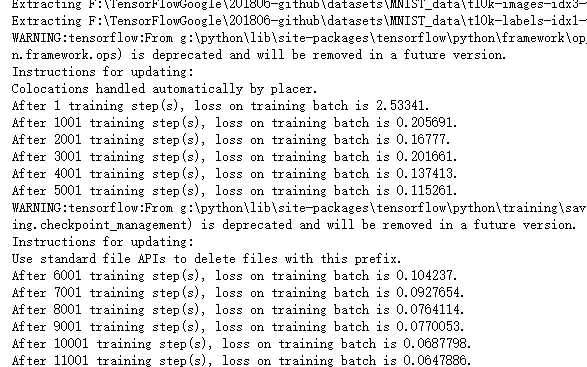吴裕雄 python 神经网络——TensorFlow 卷积神经网络手写数字图片识别
import os
import tensorflow as tf
from tensorflow.examples.tutorials.mnist import input_data INPUT_NODE = 784
OUTPUT_NODE = 10
LAYER1_NODE = 500 def get_weight_variable(shape, regularizer):
weights = tf.get_variable("weights", shape, initializer=tf.truncated_normal_initializer(stddev=0.1))
if(regularizer != None):
tf.add_to_collection('losses', regularizer(weights))
return weights def inference(input_tensor, regularizer):
with tf.variable_scope('layer1'):
weights = get_weight_variable([INPUT_NODE, LAYER1_NODE], regularizer)
biases = tf.get_variable("biases", [LAYER1_NODE], initializer=tf.constant_initializer(0.0))
layer1 = tf.nn.relu(tf.matmul(input_tensor, weights) + biases) with tf.variable_scope('layer2'):
weights = get_weight_variable([LAYER1_NODE, OUTPUT_NODE], regularizer)
biases = tf.get_variable("biases", [OUTPUT_NODE], initializer=tf.constant_initializer(0.0))
layer2 = tf.matmul(layer1, weights) + biases
return layer2 BATCH_SIZE = 100
LEARNING_RATE_BASE = 0.8
LEARNING_RATE_DECAY = 0.99
REGULARIZATION_RATE = 0.0001
TRAINING_STEPS = 30000
MOVING_AVERAGE_DECAY = 0.99
MODEL_SAVE_PATH = "F:\\TensorFlowGoogle\\201806-github\\datasets\\MNIST_data\\"
MODEL_NAME = "mnist_model" def train(mnist):
# 定义输入输出placeholder。
x = tf.placeholder(tf.float32, [None, INPUT_NODE], name='x-input')
y_ = tf.placeholder(tf.float32, [None, OUTPUT_NODE], name='y-input')
regularizer = tf.contrib.layers.l2_regularizer(REGULARIZATION_RATE)
y = inference(x, regularizer)
global_step = tf.Variable(0, trainable=False) # 定义损失函数、学习率、滑动平均操作以及训练过程。
variable_averages = tf.train.ExponentialMovingAverage(MOVING_AVERAGE_DECAY, global_step)
variables_averages_op = variable_averages.apply(tf.trainable_variables())
cross_entropy = tf.nn.sparse_softmax_cross_entropy_with_logits(logits=y, labels=tf.argmax(y_, 1))
cross_entropy_mean = tf.reduce_mean(cross_entropy)
loss = cross_entropy_mean + tf.add_n(tf.get_collection('losses'))
learning_rate = tf.train.exponential_decay(LEARNING_RATE_BASE,global_step,mnist.train.num_examples / BATCH_SIZE, LEARNING_RATE_DECAY,staircase=True)
train_step = tf.train.GradientDescentOptimizer(learning_rate).minimize(loss, global_step=global_step)
with tf.control_dependencies([train_step, variables_averages_op]):
train_op = tf.no_op(name='train')
# 初始化TensorFlow持久化类。
saver = tf.train.Saver()
with tf.Session() as sess:
tf.global_variables_initializer().run()
for i in range(TRAINING_STEPS):
xs, ys = mnist.train.next_batch(BATCH_SIZE)
_, loss_value, step = sess.run([train_op, loss, global_step], feed_dict={x: xs, y_: ys})
if i % 1000 == 0:
print("After %d training step(s), loss on training batch is %g." % (step, loss_value))
saver.save(sess, os.path.join(MODEL_SAVE_PATH, MODEL_NAME), global_step=global_step) def main(argv=None):
mnist = input_data.read_data_sets("F:\\TensorFlowGoogle\\201806-github\\datasets\\MNIST_data\\", one_hot=True)
train(mnist) if __name__ == '__main__':
main()

吴裕雄 python 神经网络——TensorFlow 卷积神经网络手写数字图片识别的更多相关文章
- 用Keras搭建神经网络 简单模版(三)—— CNN 卷积神经网络(手写数字图片识别)
# -*- coding: utf-8 -*- import numpy as np np.random.seed(1337) #for reproducibility再现性 from keras.d ...
- 吴裕雄 python神经网络 手写数字图片识别(5)
import kerasimport matplotlib.pyplot as pltfrom keras.models import Sequentialfrom keras.layers impo ...
- 吴裕雄--天生自然 Tensorflow卷积神经网络:花朵图片识别
import os import numpy as np import matplotlib.pyplot as plt from PIL import Image, ImageChops from ...
- 吴裕雄--天生自然TensorFlow2教程:手写数字问题实战
import tensorflow as tf from tensorflow import keras from keras import Sequential,datasets, layers, ...
- 用Keras搭建神经网络 简单模版(四)—— RNN Classifier 循环神经网络(手写数字图片识别)
# -*- coding: utf-8 -*- import numpy as np np.random.seed(1337) from keras.datasets import mnist fro ...
- caffe+opencv3.3dnn模块 完成手写数字图片识别
最近由于项目需要用到caffe,学习了下caffe的用法,在使用过程中也是遇到了些问题,通过上网搜索和问老师的方法解决了,在此记录下过程,方便以后查看,也希望能为和我一样的新手们提供帮助. 顺带附上老 ...
- Android+TensorFlow+CNN+MNIST 手写数字识别实现
Android+TensorFlow+CNN+MNIST 手写数字识别实现 SkySeraph 2018 Email:skyseraph00#163.com 更多精彩请直接访问SkySeraph个人站 ...
- 基于tensorflow的MNIST手写数字识别(二)--入门篇
http://www.jianshu.com/p/4195577585e6 基于tensorflow的MNIST手写字识别(一)--白话卷积神经网络模型 基于tensorflow的MNIST手写数字识 ...
- 基于TensorFlow的MNIST手写数字识别-初级
一:MNIST数据集 下载地址 MNIST是一个包含很多手写数字图片的数据集,一共4个二进制压缩文件 分别是test set images,test set labels,training se ...
随机推荐
- ArrayList集合的增、删、改、获取和长度
API : code: package student; import java.util.ArrayList; public class ArrayListDemo { public static ...
- php curl模拟post请求提交数据例子总结
php curl模拟post请求提交数据例子总结 [导读] 在php中要模拟post请求数据提交我们会使用到curl函数,下面我来给大家举几个curl模拟post请求提交数据例子有需要的朋友可参考参考 ...
- 直击JDD | 徐雷:智能化零售,以技术为驱动力的突破路径
"京东零售已经成为一家典型的以技术驱动为主的零售公司".在11月19日召开的 2019京东全球科技探索者大会上,京东零售集团CEO徐雷首次阐释了京东零售的智能化零售路径. 徐雷指出 ...
- 使用GitHub+Hexo搭建个人博客
title: CozyMo date: 2019-12-28 16:01:29 tags: 书写 前言:搭建博客要自己打代码吗? 开始动手:搭建博客的步骤 个性化:更换主题!! 写博客:初识 mark ...
- 感知机分类(perceptron classification)
概述 在机器学习中,感知机(perceptron)是二分类的线性分类模型,属于监督学习算法.输入为实例的特征向量,输出为实例的类别(取+1和-1). 感知机对应于输入空间中将实例划分为两类的分离超平面 ...
- php 去除中间空格
<?php $str = 'a b c d e'; echo preg_replace('# #','',$str);//输出 "abcde"
- 浅谈JVM - 内存结构(二)- 虚拟机栈|凡酷
2.1 定义 Java Virtual Machine Stacks(Java虚拟机栈) Java 虚拟机栈描述的是 Java 方法执行的内存模型,用于存储栈帧,是线程私有的,生命周期随着线程启动而产 ...
- drf三大认证:认证组件-权限组件-权限六表-自定义认证组件的使用
三大认证工作原理简介 认证.权限.频率 源码分析: from rest_framework.views import APIView 源码分析入口: 内部的三大认证方法封装: 三大组件的原理分析: 权 ...
- Python—快速排序算法
# _*_ coding=utf-8 _*_ """ 快速排序: 通过一趟排序将要排序的数据分割成独立的两部分,其中一部分的所有数据都比 另外一部分的所有数据都要小,然后 ...
- Codeforces 1288D - Minimax Problem
题目大意: 给定n个序列,每个序列元素个数严格相等于m 你需要找到两个序列a[i]和a[j],使其每个对应位置的元素取大后得到b序列 b[k]=max(a[i][k],a[j][k]) 且让b序列中 ...
